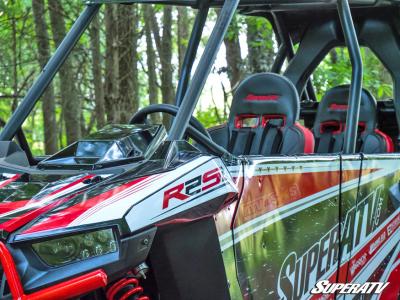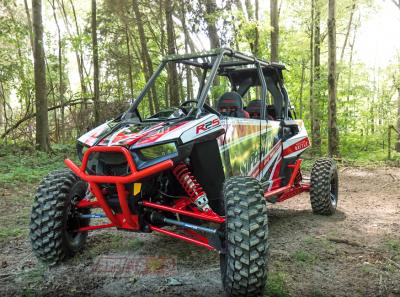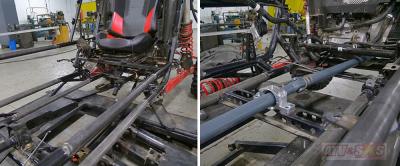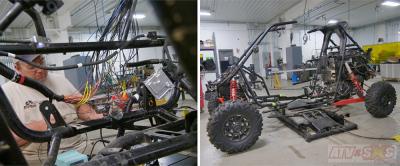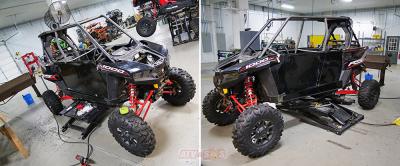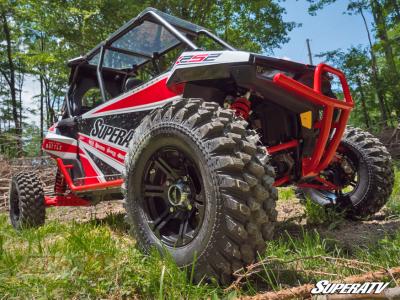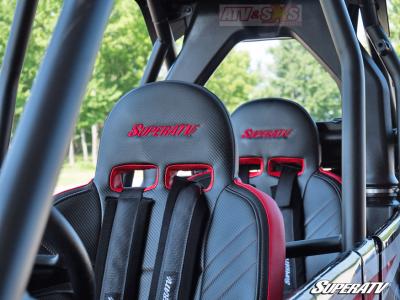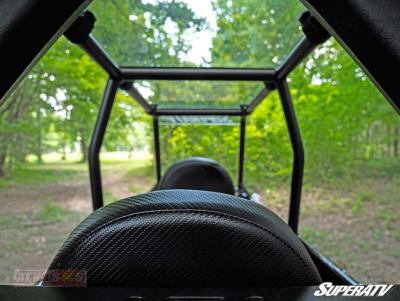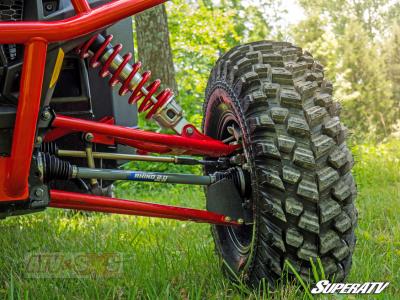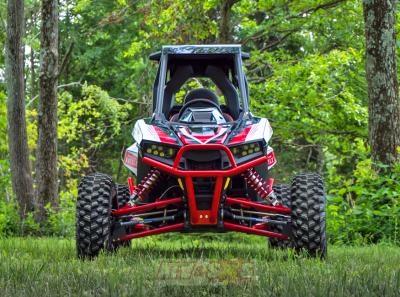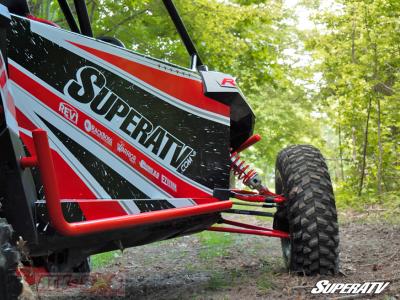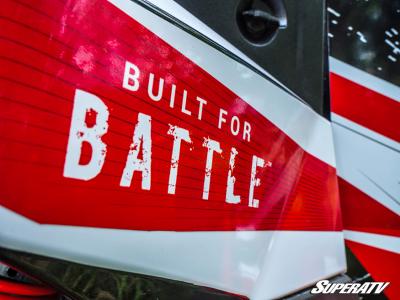Fighter planes have tandem seating, attack helicopters have tandem seating, and even bicycles have tandem seating. The advantages of a front-to-back tandem seating configuration are many. That includes better sight lines for the driver or pilot, a narrower cockpit area allowing suspension or wings to be extended for better control, and better handling from a longer chassis just to name a few. We’ve often wondered why that same seating concept has never been applied to Side x Sides. The crew at SUPERATV wondered as well.
SUPERATV – SUPER CREATIVE!
The engineers at SUPERATV have come up with some ambitious and creative projects through the years but this one really had them venturing into new territory. When the new Polaris RS1 was introduced we were excited to try the center mounted, single seat machine. The chassis is similar in design to the high performance RZR frames, with large diameter, high strength steel tubing, but in a slimmed down package. Behind it all was the potent 1000cc ProStar engine but the best part of the RS1 is the suspension. To achieve its 16” of wheel travel Polaris gave the RS1 long A-arms in the front and a trailing arm style rear end. The advantage of longer suspension arms is less camber change through the shock stroke, and that means consistent handling through the rough stuff. Many suspension parts are shared with the RZR XP1000, but the RS1 is fully 7” shorter than the XP. That means you have a great looking, nimble, high performance machine that is perfect for ripping down the trails. But it’s only got one seat. SUPERATV was quick to realize that takes away one of the primary reasons for owning a Side x Side, which is to share the adventure, but it also got their wheels turning. What if they could create a Side x Side that wasn’t a Side x Side at all? Meet the SUPERATV R2S2.
A CUT ABOVE and BELOW
It takes a strong will and a solid plan to roll a new machine into the shop and take the plasma cutter to it. It practically brings tears to ones eyes, but that’s exactly what the engineers and technicians at SUPERATV did.
Cutting the chassis between the gear shifter and the seat seemed the logical place to begin since that area has the fewest components in the way. The added benefit of cutting there was the stock fuel tank could remain with the chassis, with no special mounts or extended wiring and hoses needed. Since the radiator is mounted just behind the seat that could remain in place also. So much for the easy part: everything else would have to be extended. Details are:
WIRING HARNESS – The stock wiring harness would no longer reach the front end. That meant cutting and splicing, and since there are a lot of electronics powering and monitoring the functions on any new Side x Side or ATV there would be many connections to make. Some of those systems are also very sensitive to voltage fluctuation. New connections must be perfect, and completely sealed.
DRIVE LINE – The drive shaft would also have to be extended. To extend a drive shaft you’ll want excellent fit with very good quality welds for balance, and it will need to be indexed perfectly. You don’t want to introduce vibration into the drive shaft with sloppy work here. Above all, make sure it is aligned perfectly! A drive shaft problem can make a vehicle miserable if not impossible to drive. SuperATV went for option B, which was to install one of their Rhino Driveline Bounty Series shafts customized to the correct length. Since long drive shafts can sometimes be unstable they also installed their self-aligning carrier bearings for extra support.
CABLES – Oops.. The shift cable no longer fit. Solving the shifter cable problem was a simple matter of ordering a longer one. There are numerous cable suppliers that will gladly make a custom cable to the length you need. Another option was to find a longer Polaris vehicle with a cable that would work.
BRAKES LINES – The most important system. There was a bit of a gift to be found here, and by carefully rerouting the brake lines they actually were long enough to get the job done. The likely reason for this is they were probably from a longer Polaris vehicle and then also used on the RS1. Polaris is famous for pirating parts from one vehicle when creating a new one. They’ve never had a part they didn’t want to use 16 more times, but it’s really about manufacturing efficiency.
TUBE and WELDER TIME
The Polaris RS1 chassis is made from (HSLA) High Strength, Low Alloy steel. When doing a project like this most custom builders will use a steel called Chromoly (or 4130 as designed by the SAE – Society of Automotive Engineers). A better choice these days in the HSLA materials which can have even better strength and elongation properties for off-road, but it is often difficult to find in less than a mill run. When you only need a short piece you’ll likely have to use Chromoly.
When stretching a frame your alignment and all weld joints are critical. You must make sure the chassis is flat, with no twisting or loading on one corner by poor fitup. You’ll want a skilled welder to complete the task. Joint locations must also be chosen carefully and if you can reinforce them with a gusset that’s even better. Weld joints create stress in the materials as they cool, and too much heat causes a problem called hydrogen embrittlement. Even the weld filler rod makes a difference, and you don’t want to add carbon to the joint by using a rod with a higher carbon content than the base material. Poor welds are subject to cracks soon after, either around the heat zone or through the weld itself. That’s why you need a welder who knows what they are doing. The SuperATV welding technicians certainly planned their welds carefully. The next phase of the build was seat mounts and bodywork.
BODYWORK
With the chassis now 30” longer (from 84” to 114” wheelbase) the SuperATV crew could mount the second seat and begin to style the R2S2 with a second door and bodywork that followed the original Polaris styling. Most of the new bodywork was aluminum sheet, and new parts include a tinted roof, front and rear bumpers, full doors, and a full skid plate. Inside are SuperATV seats with 5-point harnesses to keep both riders safe. With the doors closed there is comfortable space for the passenger, and plenty of room for the driver to safely control the vehicle. A custom wrap ties it all together and gives it a factory finished look.
MEET the R2S2
SuperATVs designers wanted to preserve all that was great about the Polaris RS1 such as the great sightlines, excellent balance, and precise handling. To further enhance chassis performance they added SuperATV rear radius arms and rear trailing arms, and just to be sure the axles were capable of handling the extra load Rhino 2.0 Axles were installed. At all corners 30” Warrior tires are used.
There is no tandem seat off-road machine available from any of the large OEMs. The SuperATV R2S2 project was done just to show the possibilities and to prove performance. Although the R2S2 is a little longer than the stock Polaris RS1, the wheelbase is on par with practically every other performance Side x Side. That means it still handles well, only the R2S2 offers excellent side to side weight balance, clear vision out of the cab area, and much enhanced climbing capabilities all in a great looking package. The best feature of the R2S2 is you can once again share the adventure with a friend. And just like any great friend, they’re right behind you.
SuperATV
2753 Michigan Road, Madison, IN 47250
(855) 743-3427 www.SuperATV.com


